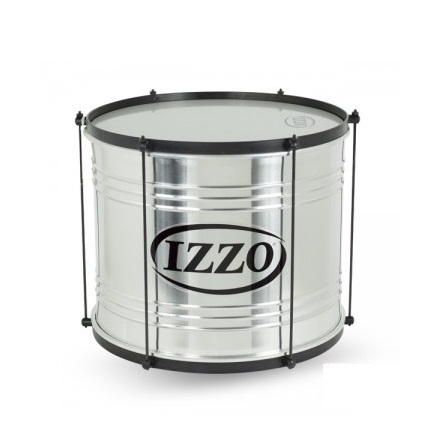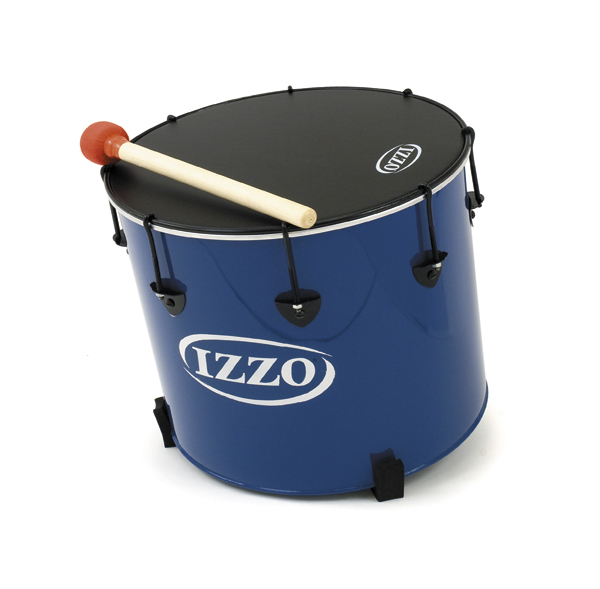Surdo
Percussions
America
Between 1001 and 1900 AD
Video
The studio is a large bass drum that forms the rhythmic foundation of Brazilian samba and many Afro-Brazilian musical styles. Known for its deep, resonant tones, the shadow is an integral part of samba ensemble and other percussion-heavy musical traditions. Its steady, heartbeat-like rhythm anchors the more intricate patterns played by smaller percussion instruments, creating a dynamic interplay that is characteristic of samba. The surdo is not just an instrument but a cultural symbol, embodying the energy, vitality, and communal spirit of Brazilian music.
Description and Type of Instrument
The surdo is a cylindrical drum with a large diameter, typically ranging from 16 to 26 inches, and a relatively shallow depth. It belongs to the membranophone family, meaning it produces sound through the vibration of a stretched membrane. The surdo is considered a type of bass drum and is known for its low-pitched, booming sound. The drumheads are usually made from animal skin or synthetic materials, and the shell is often constructed from lightweight yet durable materials like aluminum or wood.
Surdos are played with mallets, hands, or a combination of both, depending on the musical style. They are designed to project sound in outdoor and ensemble settings, making them a vital component of samba and carnival music.
History of the Surdo (Continent and Century)
The surdo originated in Brazil and is deeply rooted in the country’s Afro-Brazilian heritage. Its development is linked to the African drums brought to Brazil during the transatlantic slave trade, particularly in the 18th and 19th centuries. These African rhythms were adapted and transformed within the Brazilian context, giving rise to samba and other musical genres.
The modern surdo became prominent in the early 20th century as samba schools and carnival parades began to formalize their musical ensembles. By the 1920s and 1930s, the surdo had established itself as the backbone of samba rhythm, providing the pulse that drives the music. Its influence spread beyond Brazil, becoming an essential instrument in world music and various fusion genres.
Construction of the Surdo
The surdo is constructed with durability and resonance in mind. The shell is typically made from lightweight materials such as aluminum, steel, or wood, allowing the drum to be easily carried during parades and performances. Wooden surdos produce a warmer, fuller tone, while metal surdos offer a brighter and more cutting sound. The drumheads are made from either animal skin or synthetic materials. Animal skin, such as calfskin, provides a traditional, earthy tone but requires more maintenance due to its sensitivity to humidity and temperature changes. Synthetic drumheads, made from Mylar or similar materials, are more durable and consistent in various weather conditions.
The drumheads are tensioned over the shell using a series of tuning rods and hoops. This allows players to adjust the pitch and tone of the surdo to suit the ensemble’s needs. Some surdos are equipped with a dampening system, such as foam or felt strips, to control overtones and achieve a cleaner sound.
Types of Surdo
Surdos come in various sizes, each serving a specific role within a samba ensemble. The three main types of surdos are:
- First Surdo (Primeira): The largest surdo in the ensemble, it plays the fundamental pulse, often on the first beat of each measure. Its deep, resonant sound provides the foundation for the rhythm.
- Second Surdo (Segunda): Slightly smaller than the primeira, the segunda plays syncopated rhythms that interact with the primeira, creating a call-and-response effect. This interplay adds complexity and drive to the rhythm.
- Third Surdo (Terceira): The smallest surdo, the terceira often plays more intricate and faster rhythms, contributing to the overall texture and energy of the music.
In addition to these standard types, surdos can vary in size and tuning based on regional styles and specific musical contexts.
Features of the Surdo
The surdo’s design and features make it a unique and indispensable instrument in samba music. Key features include:
Large Diameter: The wide drumhead produces a deep, resonant sound that anchors the rhythm.
Lightweight Shell: Constructed from materials like aluminum or wood, the shell is easy to carry, even during long parades.
Tunable Heads: The ability to adjust the tension of the drumheads allows players to customize the pitch and tone.
Dampening Options: Many surdos include built-in or added dampening materials to control overtones and produce a cleaner sound.
Versatility: Surdos can be used in a variety of musical styles, from traditional samba to modern fusion genres.
Sound Production
Sound production on the Surdo involves striking one of its drumheads with a mallet while using the opposite hand to mute or strike the other head. This technique allows players to create various rhythmic patterns essential for samba music. The dynamics achieved through this method enable both steady beats and syncopated grooves, enhancing the overall energy of performances.
Playing Methods
Playing the Surdo requires specific techniques. Using a padded mallet to hit one head while muting or tapping the other with the hand. Advanced players incorporate complex rhythms and dynamic shifts. The Surdo often interacts with other percussion instruments within an ensemble, creating a cohesive musical experience.
Learning to play involves developing control over these techniques to produce clear tones and maintain rhythmic precision.
FAQ
What is the description of a Surdo musical instrument?
The Surdo is a large bass drum used primarily in Brazilian music, especially samba. It has a cylindrical shape with a drumhead on both ends and is played with a mallet or hands. Surdos come in different sizes, producing low, resonant sounds that provide the rhythmic foundation of samba. The drum’s shell is typically made from wood or metal, and the heads are either synthetic or animal hide.
What is the origin of the Surdo musical instrument?
The Surdo originates from Brazil and is an integral part of samba music. It was developed in the early 20th century as samba evolved in Rio de Janeiro. The instrument draws influence from African drums, brought to Brazil by enslaved Africans. Over time, the Surdo became a key element in Brazilian percussion ensembles, especially in carnival parades.
What are the different types of Surdo drums?
Surdos are categorized by size and pitch, typically into first, second, and third Surdos. The first Surdo (largest) plays the deepest, lowest-pitched rhythms. The second Surdo provides syncopation with a medium pitch, while the third (smallest) Surdo adds higher-pitched, rhythmic accents. These types work together to create the rich, layered rhythms of samba.
 Links
Links
References
Other Instrument
Categories



















